[Date Prev][Date Next][Thread Prev][Thread Next][Date Index][Thread Index]
02/03: website: music-production-on-guix-system: Tweak and publish.
|
From: |
Ricardo Wurmus |
|
Subject: |
02/03: website: music-production-on-guix-system: Tweak and publish. |
|
Date: |
Thu, 26 Nov 2020 09:36:03 -0500 (EST) |
rekado pushed a commit to branch master
in repository guix-artwork.
commit f296db5eedba0f6d135e4c9242ca83a90c2aea14
Author: Ricardo Wurmus <rekado@elephly.net>
AuthorDate: Thu Nov 26 15:31:04 2020 +0100
website: music-production-on-guix-system: Tweak and publish.
* website/drafts/music-production-on-guix-system.md: Move this file
from here...
* website/posts/music-production-on-guix-system.md: ...to here; fix
URLs, add images, fix typography, and add blurb about Guix.
---
.../music-production-on-guix-system.md | 149 +++++++++++++--------
1 file changed, 95 insertions(+), 54 deletions(-)
diff --git a/website/drafts/music-production-on-guix-system.md
b/website/posts/music-production-on-guix-system.md
similarity index 66%
rename from website/drafts/music-production-on-guix-system.md
rename to website/posts/music-production-on-guix-system.md
index 5ebb78d..013209c 100644
--- a/website/drafts/music-production-on-guix-system.md
+++ b/website/posts/music-production-on-guix-system.md
@@ -1,5 +1,5 @@
title: Music Production on Guix System
-date: 2020-11-24 23:00
+date: 2020-11-26 15:30
author: Ricardo Wurmus
tags: Music
---
@@ -8,39 +8,41 @@ The recent release of Guix 1.2.0 was accompanied by a release
song.
Let me tell you how this happened and how you can use Guix System for
your own music productions!
-It all started only three days before the 1.2.0 release when someone
-on the `#guix` IRC channel brought up the tradition of OpenBSD people
-to write, record, and publish at least one song alongside their system
-release:
+
- https://logs.guix.gnu.org/guix/2020-11-20.log#142825
+It all started only three days before the 1.2.0 release when [someone
+on the `#guix` IRC channel brought
+up](https://logs.guix.gnu.org/guix/2020-11-20.log#142825) the
+[tradition of OpenBSD people to write, record, and publish at least
+one song](https://www.openbsd.org/lyrics.html) alongside their system
+releases.
A wistful look at my neglected instruments later I felt compelled to
take this as a challenge: with less than three days to go could we
actually compose, record, and publish a song using nothing but free
software despite a jam-packed weekend schedule? I wanted to find out.
-## Inspiration and Planning
+### Inspiration and Planning
-The working title "Ode to One Two Oh" was an obvious choice, being a
+The working title *“Ode to One Two Oh”* was an obvious choice, being a
quasi-palindrome, and its five syllables suggested a time signature of
5/4. Where to from here?
As I stared at my Emacs session with a Guile REPL (read, eval, print,
-loop) buffer I tried to recall what the letters "REPL" stand for.
-Clearly, in my case the "P" was for "Procrastination", but what about
+loop) buffer I tried to recall what the letters “REPL” stand for.
+Clearly, in my case the “P” was for “Procrastination”, but what about
the others? I had stumbled upon the chorus: a description of the Guix
development process. Contribute as others before us have shared their
-contributions ("Reciprocation"), review patches and discuss
-("Evaluation"), hack on something else ("Procrastination"), and repeat
-("Loop").
+contributions (*Reciprocation*), review patches and discuss
+(*Evaluation*), hack on something else (*Procrastination*), and repeat
+(*Loop*).
The words suggested a simple descending melody, which would need to be
elevated by a somewhat less simple chord progression. After trying
out a few harmonies on the Grand Stick I remembered how terrible my
memory was and decided that I would need to scatter the harmonies onto
a canvas, listen to the whole progression, and adjust the lines as
-needed --- all *without* having to build up muscle memory for
+needed — all *without* having to build up muscle memory for
harmonies and progressions I may very well end up discarding in the
process.
@@ -50,12 +52,12 @@ approach, whereas I decided to hone in on the exact
harmonies with an
unlikely tool: the unparalleled [music engraving application
Lilypond](https://lilypond.org/). Lilypond sports a versatile
language that covers primitive note input, the means of combining them
-to larger phrases and musical ideas, and the means of abstraction ---
+to larger phrases and musical ideas, and the means of abstraction —
it allows for musical ideas to be named and recombined in different
-shapes. For everything the language doesn't account for with
+shapes. For everything the language doesn’t account for with
specialized syntax I can simply switch to Guile Scheme. No other
notation software is as flexible and malleable as Lilypond. I let it
-generate both sheet music and a MIDI file --- the sheet music is
+generate both sheet music and a MIDI file — the sheet music is
displayed in a PDF viewer in Emacs and the MIDI file sent to
`fluidsynth` (because I trust my ears over my eyes).
@@ -68,7 +70,7 @@ minimum, because a composition workflow that is firmly rooted
in MIDI
tends to result in music that sounds sterile or robotic, an
undesirable quality that can be hard to eradicate later. So I put
them aside and focused on another part of the song. Mirroring the
-quasi-palindrome of the title, the song's structure would be A B C B
+quasi-palindrome of the title, the song’s structure would be A B C B
A. With the smooth chords of the B section locked down I walked up to
the Grand Stick (I mounted it on a modified microphone stand for more
flexibility) and tapped out a contrasting two-handed funky bass line
@@ -76,17 +78,21 @@ to the click of a metronome.
Time to record!
-## Audio Recording
+### Audio Recording
How does the signal of my stringed instrument make it into a file on
-my computer's disk? The Stick's stereo signal feeds into two
+my computer’s disk? The Stick’s stereo signal feeds into two
daisy-chained [Axoloti boards](http://www.axoloti.com/) with
[hand-crafted](https://guix.gnu.org/en/packages/axoloti-patcher-1.0.12-2/)
signal processing tuned to the peculiarities of my instrument; the
stereo output of the DSP boards is connected to two inputs on my USB
audio interface (the Tascam US16x08, though any class-compliant audio
interface will work just fine), which presents itself to the system as
-a 16 channel input sound card. The computer runs [JACK
+a 16 channel input sound card.
+
+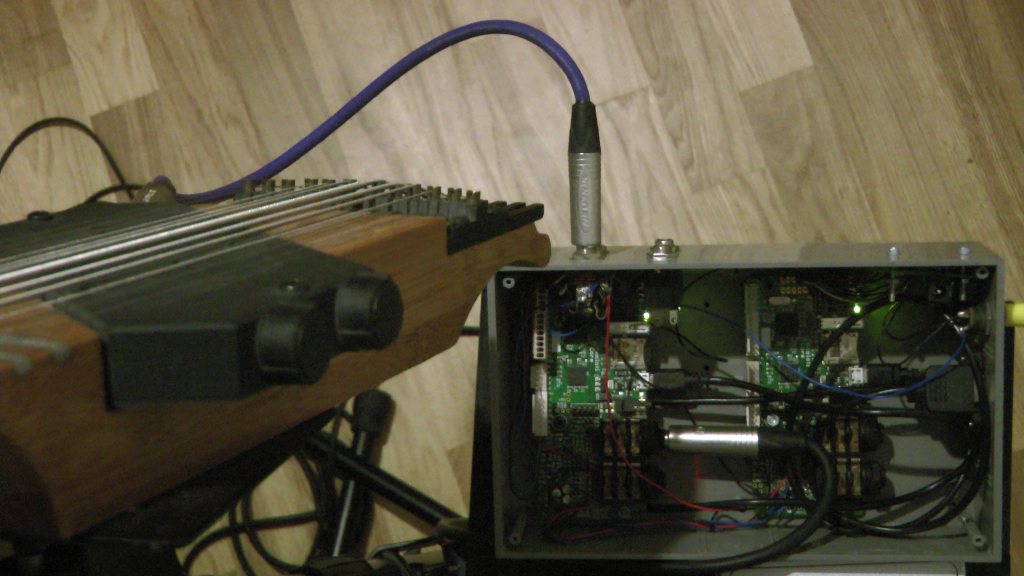
+
+The computer runs [JACK
1](https://guix.gnu.org/en/packages/jack-0.125.0/) to shuffle the
incoming signals on all channels to other JACK clients (audio
applications and plugins). I use
@@ -94,6 +100,8 @@ applications and plugins). I use
conveniently wire up inputs and outputs in an interactive graphical
signal flow diagram.
+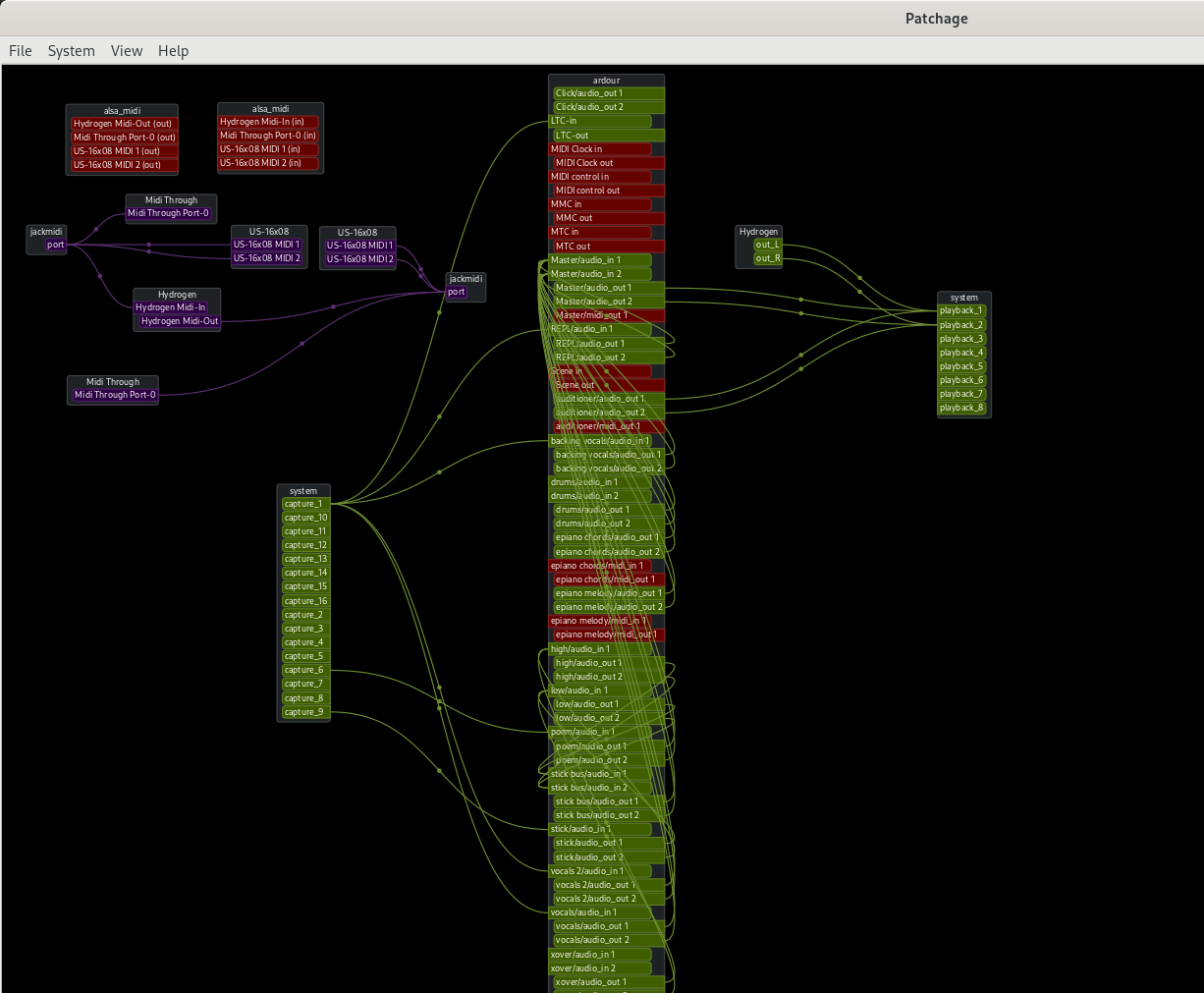
+
The center piece of my recording session is the venerable
[Ardour](https://guix.gnu.org/en/packages/ardour-5.12/), an incredibly
flexible and polished digital audio workstation (DAW) that natively
@@ -102,29 +110,31 @@ plugin host.
Okay, the Stick is ready to be recorded, but I prefer to record a drum
track first instead of playing to the click of a metronome. But wait,
-I really can't record the drums now! This is an apartment and the
-neighbors are asleep. Oh, and I'm a lousy funk drummer. Let's cheat!
+I really can’t record the drums now! This is an apartment and the
+neighbors are asleep. Oh, and I’m a lousy funk drummer. Let’s cheat!
+
+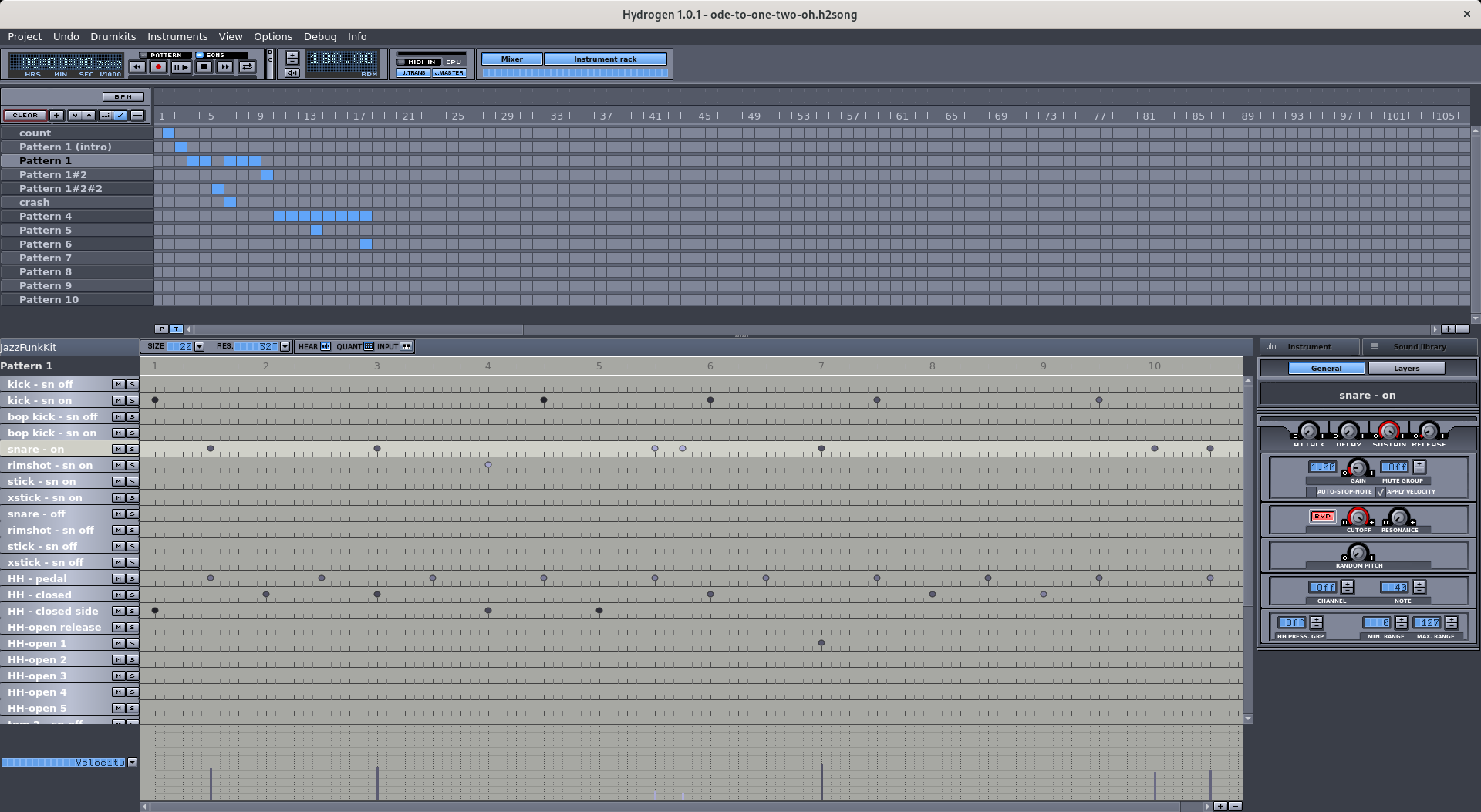
My drum machine of choice is
[Hydrogen](https://guix.gnu.org/en/packages/hydrogen-1.0.1/). It lets
me create any number of arbitrarily long patterns, combine them, and
---- that's crucially important --- sync up with other JACK
+— that’s crucially important — sync up with other JACK
applications such as Ardour. I toggled a button in Ardour to let it
take control of the JACK transport, meaning that when I start
-recording in Ardour the drum machine starts playing in sync ---
-perfect! Let's roll!
+recording in Ardour the drum machine starts playing in sync —
+perfect! Let’s roll!
-## Rough Processing
+### Rough Processing
After frustrating minutes had turned into exhausting hours of
recording the bass line (eventually resorting to punching in and out
instead of re-recording *everything* whenever I made an audible
-mistake) I put my arranger's hat on and tried to get a sense for what
-might still be missing. The recorded track sounded rather "flat";
-after all this was the "raw" signal straight from the instrument's
+mistake) I put my arranger’s hat on and tried to get a sense for what
+might still be missing. The recorded track sounded rather “flat”;
+after all this was the “raw” signal straight from the instrument’s
pre-amplifier. Time to spruce it up and approximate the final sound!
-Over the years the selection of audio plugins that I'm using to
+Over the years the selection of audio plugins that I’m using to
process my recordings has narrowed down to few more than the [Calf
suite of LV2 plugins](https://guix.gnu.org/en/packages/calf-0.90.3/).
I will admit to being an extremely superficial person, so a big factor
@@ -135,46 +145,48 @@ they make it easy to tweak the many parameters and come
with helpful
diagnostics (such as listening only to the changed frequencies, or
spectral visualizations, etc).
+
+
First thing I do is to use light compression to even out slight
variations in dynamics. Calf Mono Compressor does the job here. The
principle is simple: a compressor *lowers* the volume when a sound
gets loud and it *raises* the volume of the resulting signal according
to the dialed in makeup gain. It has a bunch of other knobs to
control how far ahead it will look to watch out for loud sounds,
-another to prevent "pumping" (too rapid activation and deactivation),
-another to smooth out the "knee" of the threshold curve, etc --- but
+another to prevent “pumping” (too rapid activation and deactivation),
+another to smooth out the “knee” of the threshold curve, etc — but
what it really comes down to is: at what level should the signal be
-reduced, by how much, and what's the gain to make up for the overall
+reduced, by how much, and what’s the gain to make up for the overall
loss in volume.
One piece of advice: resist the temptation of overdoing this!
-Compression may make the sound punchier, but don't throw away all
-dynamics here or you'll risk draining the life from your hard-earned
+Compression may make the sound punchier, but don’t throw away all
+dynamics here or you’ll risk draining the life from your hard-earned
waveforms. So I stick with a ratio of no more than two, keep the
makeup gain fairly low, and the threshold somewhat high to only
trigger the compressor in the upper fifth of the dynamic range.
Next: equalization. This is to scoop out an unpleasant character by
attenuating certain frequency ranges. Again, the Calf suite has got
-me covered. A five band EQ is sufficient as I don't want to be
+me covered. A five band EQ is sufficient as I don’t want to be
tempted to make sharp cuts in the frequency spectrum of the signal.
-As a general rule I don't *boost* any frequencies but primarily *cut*.
-Here, too, the key is to be gentle. Don't cut more than two or three
-decibels or you'll end up with a comically filtered sound.
+As a general rule I don’t *boost* any frequencies but primarily *cut*.
+Here, too, the key is to be gentle. Don’t cut more than two or three
+decibels or you’ll end up with a comically filtered sound.
(Exceptions apply for drum recordings, but thankfully we dodged that
bullet by using Hydrogen.) If you find that you need to cut or boost
more than that, chances are that there are problems with your
-recording. Don't try to compensate for problems with post-processing
+recording. Don’t try to compensate for problems with post-processing
that could have been avoided by improving the recording quality. I
scoop out the mids a tiny bit and cut out the *very* low bass
-frequencies that don't contribute anything more than a rumble.
+frequencies that don’t contribute anything more than a rumble.
-## MIDI Resurgence
+### MIDI Resurgence
With the bass line and the drums in place it was time to revisit the
harmonies for part B. I really did want to record them with my very
red virtual analog hardware synthesizer, but when I brought it into my
-tiny work room I realized that I had ran out of space on my lap --- I
+tiny work room I realized that I had ran out of space on my lap — I
had run out of space on my desk months ago, and with all those audio
cables piling up on the floor even that was no option.
@@ -185,18 +197,24 @@ a synthesizer to the track, and expanded the track
vertically to drag
around every MIDI note event by hand, refining the notes and adding
tiny timing and velocity imperfections to make it seem as if a human
played them. To paper over the clearly audible undesirable
-imperfections of the plugin's sound generation I added some Calf
+imperfections of the plugin’s sound generation I added some Calf
Reverb (for the graphics people: adding reverb is roughly equivalent
-to using the blur tool in a graphics application).
+to using the blur tool in a graphics application). I could have
+picked one of the many better synthesizers and emulators, but [we go
+way
+back](https://git.elephly.net/gitweb.cgi?p=software/lv2-mdametapiano.git;a=commit;h=c0e1b6bd5e851fc6912e00f0bcea290044ca33f8),
+this plugin and I.
-MIDI support in Ardour is really well thought-out as you don't need to
+MIDI support in Ardour is really well thought-out as you don’t need to
ever leave the main window, so you are always surrounded by audio
context. You just expand the track vertically and have as much access
to the events as you want. This approach may be a little unusual for
those who are used to MIDI sequencers, but for my purposes it is close
to perfect.
-## Lyrics and Vocals: Human vs Machine
+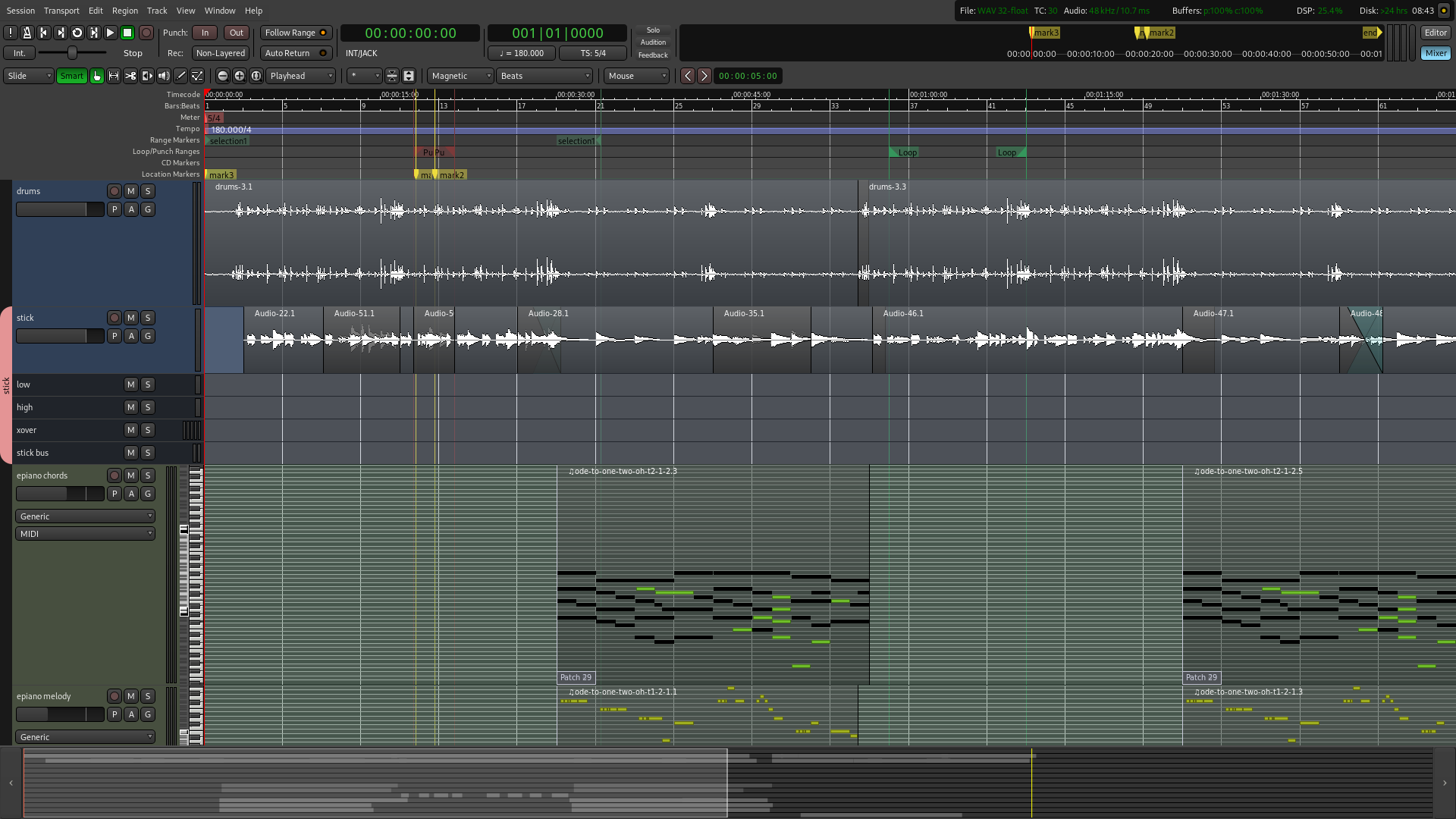
+
+### Lyrics and Vocals: Human vs Machine
At this point things were coming together nicely, but we only had
lyrics (and handful of words, really) for the chorus. Not enough for
@@ -221,12 +239,12 @@ the role of the human contemplating this cycle of
creation through
hacking by recording three vocal lines (two low, one high) for the
chorus.
-## Final touches
+### Final touches
With about half an hour or so left before the release announcement it
-became clear that there would be no "audio mastering" in the
+became clear that there would be no “audio mastering” in the
traditional sense. I put on my monitoring headphones (flat frequency
-response for an "objective" mixing experience) and adjusted the volume
+response for an “objective” mixing experience) and adjusted the volume
levels, plugin settings, and faded in and out the noisy edges of each
take. I also added a few more effects: a phaser on the Chapman Stick
track to emphasize that this is supposed to be funk; a crossover (Calf
@@ -236,16 +254,39 @@ different amplifier simulations) and then to rejoin them;
and a
limiter on the master bus to avoid any volume spikes above 0dB and to
compress the mix.
+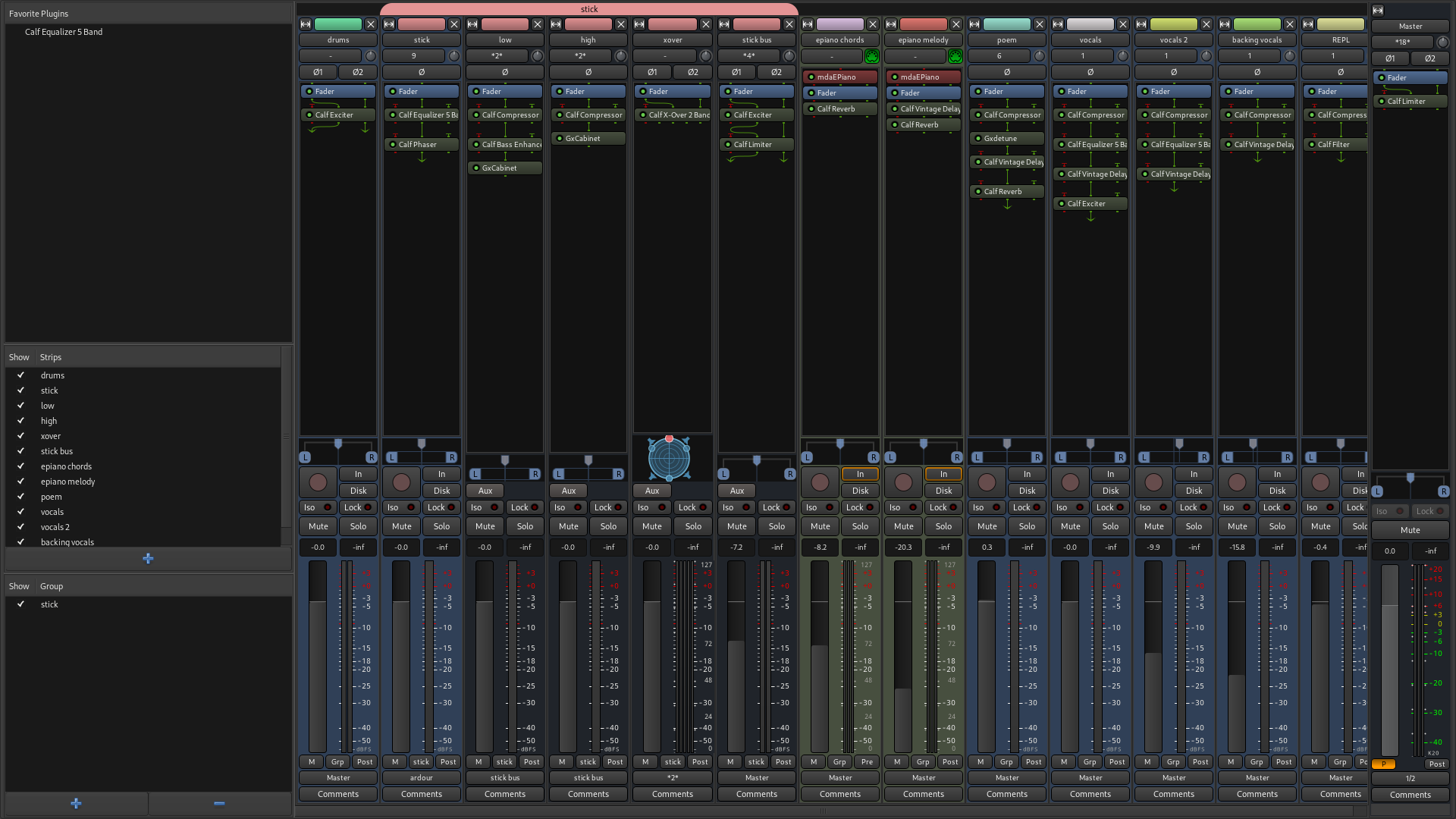
+
I exported the final mix as a Vorbis OGG audio file and sent it off to
Ludovic to have it included in the release announcement.
-## Concluding thoughts
+### Concluding Thoughts
-So what's the verdict? Is the result perfect? Absolutely not! But I
+
+
+So what’s the verdict? Is the result perfect? Absolutely not! But I
do want to point out that any and all mistakes and imperfections are
-entirely due to my own lack of skill and time --- they are not the
+entirely due to my own lack of skill and time — they are not the
result of the limitations of free software. A more skilled audio
engineer would certainly not be limited by a system like the one I
used, a system composed entirely of freedom-respecting software that
is made extra reliable by the user-empowering and liberating features
of Guix System.
+
+## About GNU Guix
+
+[GNU Guix](https://www.gnu.org/software/guix) is a transactional package
+manager and an advanced distribution of the GNU system that [respects
+user
+freedom](https://www.gnu.org/distros/free-system-distribution-guidelines.html).
+Guix can be used on top of any system running the Hurd or the Linux
+kernel, or it can be used as a standalone operating system distribution
+for i686, x86_64, ARMv7, and AArch64 machines.
+
+In addition to standard package management features, Guix supports
+transactional upgrades and roll-backs, unprivileged package management,
+per-user profiles, and garbage collection. When used as a standalone
+GNU/Linux distribution, Guix offers a declarative, stateless approach to
+operating system configuration management. Guix is highly customizable
+and hackable through [Guile](https://www.gnu.org/software/guile)
+programming interfaces and extensions to the
+[Scheme](http://schemers.org) language.